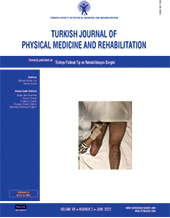Assessment of the relationship between rectus femoris cross-sectional area and knee extension strength in the prosthesis users with transtibial amputation: A case-control study
Patients and methods: Between October 2018 and April 2019, a total of 14 prosthesis users (12 males, 2 females; mean age: 47.1±16.2 years; range, 26 to 73 years) who met the inclusion criteria, and 14 age-, sex-, and dominancy-matched able-bodied controls (12 males, 2 females; mean age: 47.1±16.2 years; range, 26 to 73 years) were included in this case-control study. Cross-sectional area of rectus femoris (CSA-RF) was evaluated bilaterally by two independent examiners. Knee extension strength was measured bilaterally by using a handheld dynamometer. Functional strength and walking were assessed by Step-Up-Over and Walk-Across tests of the NeuroCom Balance Master® device.
Results: The CSA-RF was found to be reduced in amputated-limb compared to the intact-limb and able-bodied controls (p<0.01). In the prosthesis users, the cross-sectional area difference between both limbs rectus femoris muscles was shown to be correlated with actual and functional knee extension strength, step length, and walking speed (p<0.05). Intra- and inter-observer reliability of CSA-RF on both sides were found to be good to excellent (intraclass correlation coefficient: 0.856-0.936).
Conclusion: Ultrasonographic measurement of CSA-RF is a valid and reliable tool to assess the functional strength and walking in the prosthesis users with unilateral transtibial amputation.
Keywords : Amputees, muscle strength, rectus femoris, rehabilitation

















